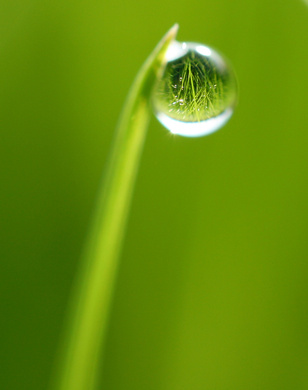During dry and hot weather the need to water your green properly can't be over emphasised. Although it can be tempting to let the green burn to achieve speed, this can turn to disaster and cause the green to fail later in the season.


During dry and hot weather the need to water your green properly can't be over emphasised. Although it can be tempting to let the green burn to achieve speed, this can turn to disaster and cause the green to fail later in the season.

Green speed is always a hot topic at this time of year and the most popular methods for achieving increased speed are usually to turn off the water and set the mower down; both of which can cause long term damage to the green.
Mowing the green regularly below 5mm can really start to harm it in terms of sward composition, drought resistance and general turf health. Rooting depth is directly proportionate to the amount of leaf that remains above, so at the very time that the turf needs deeper roots to seek out deeper lying moisture, we restrict its ability to put down roots by shaving the leaf off to within a millimetre of its life! Shaving the green too low can cause irreversible damage to the crown of the grass plants, which causes bare areas or at least areas of weakened turf, which will inevitably be taken over by meadow grass, weeds and/or moss.
The other big mistake that many clubs make is to turn off the water in an effort to induce greater green speed. Although droughting will rarely kill a green off completely, we are seeing some very high temperatures this summer and it is possible that greens will fail if not given enough irrigation. But that’s another story which you can read about here.
So, what can be done to increase green speed without causing damage to the green?
Well, to really get the speed up we need to be thinking about reducing the lateral growth on the green. There are a number of factors that can help to increase green speed and consistency for play and we’ve set them out in our guide which you can find by clicking here.
Today however, I want to concentrate on lateral growth and its affect on green speed. On many greens I visit I am told that the green is being cut at 4mm and that the members are still complaining about the green being heavy! On most occasions when confronted with this, it is possible to take the palm of your hand across the turf and tease some of the grass up to 10 or even 15mm in height!…now think about that for a minute; how “heavy” would the green be if cut at that height?
This phenomenon is due to a problem called lateral (or sideways) growth where the grass plants exhibit a recumbent growth habit and don’t stand up straight, meaning that they are not cut at the required height.
What’s the answer?
To overcome this problem we need to make allowance in our maintenance program for dealing with lateral growth. This can be achieved by several means, in order of importance these are:
There are many more tips on green speed in our green speed section here.
Density is perhaps the most important component of turf grass quality. When rating the visual quality of turf it is the shoot density of the grass plants above all else that impacts on the look and function of the turf.
Unlike unoformity, turf grass density can be measured by counting the number of shoots or leaves per unit area although this is rarely done in practice.
A high turf grass density helps to crowd out competition form weeds and weed grasses and is a key quality in producing smooth and fast greens.
The shooting density can vary widely between species and also between individual cultivars within the same species.
The cultural practices employed in maintaiing the turf also contribute to shoot density as does the growth habit of the grass type used. The seeding density and the success of the initial establishment program can also be important factors in the relative density of the non-creeping turf grass species such as chewings fescue and browntop bent.
Attention to soil moisture, mowing heights and correct turf nutrition all have a role to play in increasing the shoot density. Bentgrass typically produces the most dense turf with shoot densities sometimes reaching over 1,700 shoots per square decimeter, which is equivalent to 164.8 billion shoots per acre.
 Over the next few weeks I will publish a few articles to help you to evaluate
Over the next few weeks I will publish a few articles to help you to evaluateWithin this series I will demonstrate how it is possible to formulate “a theory of everything” for want of a better name, that can guide us in the right direction if we care to listen and take note for the improvement of turf performance for bowling or sports in general.
Over the series we will see how all of the available methods of evaluation point by and large to the same root causes and that to improve turf performance we actually have to improve turf and soil health.
The first of these qualities is Uniformity which is an estimate of the even appearance of a turf.
High quality turf should be uniform in appearance. The presence of Read more
Cation Exchange Capacity (CEC) describes the mechanism by which the main plant nutrient ions are held in the soil. Low CEC can cause nutritional problems for our turfgrass plants and is usually an indicator of very high sand content, low pH or both.